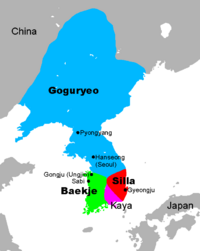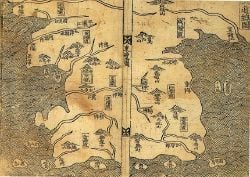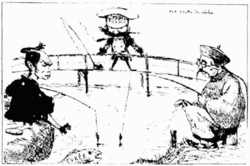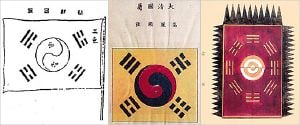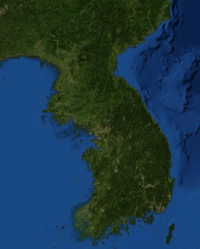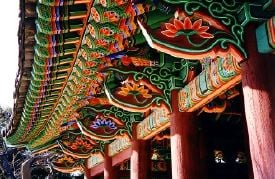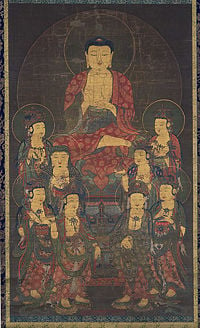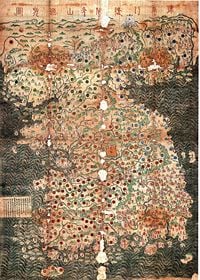Korea
| Korea | |
|---|---|
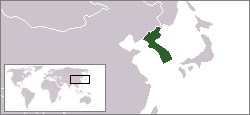
| |
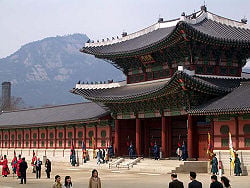
| |
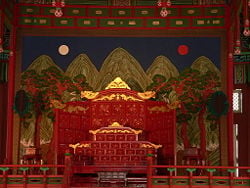
|
Korea has one of the longest continuous histories of any kingdom or nation in the world, if the 3000 B.C.E. to 2333 B.C.E. founding date for Gojoseon, the birth kingdom of Korea, is correct. Even if that date is in error, we know Gojoseon existed as a powerful kingdom around 400 B.C.E., still making Korea's continuous history one of the longest in the world. China's relationship with Korea throughout that time has been intimate, Korean culture to a large extent inherited from China. Buddhism, Confucianism, Daoism, and Christianity came from China and developed, at least initially, with Chinese help. Korea developed a unique culture, though, through the cycles of dynasties beginning with Gojoseon and ending with Joseon. The Reunification of North and South Korea may bring a rebirth of Korea and a new golden age experienced in each of the earlier dynasties.
Korea (Korean: 한국 in South Korea or 조선 in North Korea, see below), a geographic area, civilization, and former state situated on the Korean Peninsula in East Asia, currently exists divided into North Korea and South Korea. The borders of Korea have fluctuated throughout history with the rise and fall of dynasties. Although Korea exists divided into North Korea and South Korea today, Korea historical embraces north and south. China shares Korea's northwest border while The Russia shares the northeast. Japan sits to the southeast across the Korea Strait.
Overview
The history of Korea began with the mythical kingdom of Gojoseon founded by Dangun in 2333 B.C.E. Linguistic studies suggest that, if indeed the kingdom of Gojoseon actually existed, the people would have had Altaic origins, whose northern Mongolian Steppe culture absorbed immigrants and invaders from northern Manchuria, Mongolia, and China.
The adoption of the Chinese writing system ("hanja" in Korean) in the second century B.C.E., and Buddhism in the fourth century C.E., profoundly impacted the culture of the Three Kingdoms of Korea. Evidence exists that Korea, during the Three Kingdom Period, profoundly impacted the development of Japanese Buddhism and Japan's culture. [1] [2] [3][4]
After the unification of the Three Kingdoms by Silla in 676 C.E., a single government ruled Korea, preserving political and cultural independence, until the late nineteenth century, despite the Mongol invasions of the Goryeo Dynasty in the thirteenth century and Japanese invasions of the Joseon Dynasty in the sixteenth century. In 1377, Korea produced the Jikji, the world's oldest movable metal print document.[5] In the fifteenth century, the Korean navy deployed the turtle ships, possibly the world's first ironclad warships, and during the reign of King Sejong, scholars created the Korean alphabet han-geul.
During the latter part of the Joseon Dynasty, Korea's isolationist policy earned the Western nickname the "Hermit Kingdom." By the late nineteenth century, the country became the object of colonial designs by the imperial designs of Japan and Russia. In 1910, Japan succeeded in annexing Korea, maintaining tight control of Korean political and cultural life until August 1945 and the end of World War II.
In August 1945, the forces of the Soviet Union and the United States agreed on a plan for conducting the surrender and disarming of Japanese troops in Korea. The Soviet Union accepted the surrender of Japanese forces north of the 38th parallel and the United States accepted surrender south of the 38th parallel. When the Soviet Union refused to conduct democratic elections in the north, a permanent division of Korea resulted. The Soviet Union installed a communist government under the dictatorship of Kim Il-sung while the United States supported a pro-democratic, pro-USA government. The Cold War became colder with that development. Korea's current division into North Korea and South Korea traces back to that division.
Names of Korea
The name "Korea(한국)" derives from the Goryeo(고려) period of Korean history, which in turn referred to the ancient kingdom of Goguryeo. Merchants of the Middle East called it Goryeo, Koryo, which then came to be spelled Corea and Korea. Both North and South Korea commonly use Korea in English contexts. The Korean language refers to Korea to as Chosŏn (Korean chosŏn'gŭl: 조선; hanja: 朝鮮; McCune-Reischauer: Chosǒn; revised: Joseon ) by North Korea and Han-guk (hangul: 한국; hanja: 韓國; revised: Hanguk; McCune-Reischauer: Han'guk) by South Korea. "The Land of the Morning Calm," a Western nickname, loosely derives from the hanja characters for Joseon. (Chosŏn and Joseon represent two Romanized spellings of the same name.)
History
|
Jeulmun Period
|
Prehistory and Gojoseon
Archaeological evidence that people lived on the Korean Peninsula around 700,000 years ago, during the Lower Paleolithic, exists. The earliest known Korean pottery dates to around 8000 B.C.E., and the Neolithic period begins around 6000 B.C.E.
Gojoseon's founding legend describes Dangun, a descendant of heaven, as establishing the kingdom in 2333 B.C.E.[6] Archaeological and contemporary written records indicate it developed from a federation of walled cities into a centralized kingdom sometime between the seventh and fourth centuries B.C.E. The original capital may have been at the Manchuria-Korea border, but later moved to the location of Pyongyang, North Korea. In 108 B.C.E., the Chinese Han Dynasty defeated Wiman Joseon and installed four commanderies in the area of Liaoning and the northern Korean peninsula. Subsequent Chinese immigrations from Yan and Qi brought elements of Chinese culture to the peninsula. By 75 B.C.E., three of those commanderies had fallen, but the Lelang Commandery remained under successive Chinese control until 313 C.E.
Three Kingdoms
The Three Kingdoms of Korea (Goguryeo, Silla, and Baekje) dominated the peninsula and parts of Manchuria during the early Common Era. They competed with each other both economically and militarily. Goguryeo united Buyeo, Okjeo, Dongye and other states in the former Gojoseon territory, in addition to destroying the last Chinese commandery.[7]
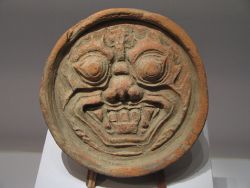
Goguryeo, the dominant power, constantly fought with the Sui and Tang dynasties of China. Founded around today's Seoul, the southwestern kingdom Baekje expanded far beyond Pyongyang during the peak of its powers in the 4th century. Although later records claim Silla, in the southeast, as the oldest of the three kingdoms, historians believe Silla to have been the last kingdom to develop.
Unified Silla and Balhae
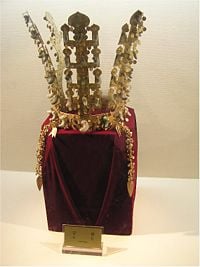
In the fifth, sixth, and seventh centuries, Silla's power gradually extended across the Korean Peninsula. Silla first annexed the adjacent Gaya confederacy. By the 660s, Silla formed an alliance with the Tang Dynasty of China to conquer Baekje and later Goguryeo. After repelling Chinese forces, Silla unified most of the Peninsula, beginning a period often called Unified Silla.
In the north, former Goguryeo General Dae Joyeong led a group of Goguryeo refugees to the Jilin area in Manchuria and founded Balhae (698 C.E. - 926 C.E.) as the successor to Goguryeo. At its height, Balhae's territory extended from northern Manchuria down to the northern provinces of modern-day Korea. The Khitans destroyed Balhae by in 926.
Unified Silla fell apart in the late ninth century, giving way to the tumultuous Later Three Kingdoms period (892-935). Goryeo unified the Later Three Kingdoms and absorbed Balhae refugees.
Goryeo
The Goryeo Dynasty, established in 918, united the Later Three Kingdoms in 935. Goryeo pottery — the famous Korean celadon pottery — and the Tripitaka Koreana — the Buddhist scriptures represent two of Goryeo's greatest contributions. (Tripitaka Koreana) carved onto roughly 80,000 wooden blocks which have been perfectly preserved. Goryeo also created the world's first metal-based movable type printing press in 1234.
Joseon dynasty
- Main Article: Joseon Dynasty
In 1392, the general Yi Seong-gye established the Joseon Dynasty (1392-1910) in a largely bloodless coup, by abandoning the previous capital and creating his own new capital hundreds of miles south. Many argue that the Joseon Dynasty had the longest-lived actively ruling dynasty in East Asia. King Sejong the Great (1418-1450) promulgated Hangul, the Korean written alphabet, and this period saw various other cultural and technological advances, as well as the dominance of Neo-Confucianism over the entire peninsula. Between 1592 and 1598, Japan invaded Korea causing enormous destruction before retreating in defeat. That war also saw the brilliant career of Admiral Yi Sunsin and his "Turtle ship" or gobukseon. In the 1620s and 1630s Joseon suffered invasions by the Manchu Qing Dynasty, who eventually also conquered the Chinese Ming Dynasty. During the Joseon dynasty, Koreans brought Roman Catholicism (and other forms of Christianity followed shortly thereafter) into Korea.
Japanese occupation
Beginning in the 1870s, Japan began to pressure Korea to move out of China's sphere of influence into its own. Japan forced Korea to engage in foreign trade through the Treaty of Ganghwa in 1876. In 1895, Japanese under Miura Gorō's directive assassinated Empress Myeongseong.[8] An Jung-geun assassinated the former Resident-General of Korea, Itō Hirobumi on October 26, 1909, which sealed Korea's fate as a colony of Japan. In 1910, Japan forced Korea to sign the Japan-Korea Annexation Treaty, executed by Korean ministers and advisors as full-powered attorney assigned by Sunjong of Korean Empire.[9] The Korean Emperor never ratified the treaty, refusing to apply the Korean Imperial seal.
Korean resisted Japan's occupation in the nonviolent March 1st Movement of 1919, where Japanese police and military killed 7000 demonstrators. Thereafter the Korean independence movement restricted activities in neighboring Manchuria and Siberia. Beginning in 1939, Japan conscripted over five million Koreans for labor and Japan's military[10] and impressing approximately 200,000 girls and women, mostly from Korea and China, into work as prostitutes, euphemistically called "comfort women."[11]
The Japanese colonial government banned the Korean language in official documents and obligated Koreans to adopt Japanese names.[12] Traditional Korean culture suffered heavy loses, as Japan destroyed numerous Korean cultural artifacts[13] or took them to Japan. To this day, valuable Korean artifacts are in Japanese museums or with private collectors, many in the United States.
Korean War
With the defeat of Japan in 1945, the United Nations developed plans for a trusteeship administration, the Soviet Union administering the peninsula north of the 38th parallel and the United States administering the south. The politics of the Cold War resulted in the 1948 establishment of two separate governments, North Korea and South Korea.
During the Korean War (1950-1953), millions of civilians died; approximately six million refugees sought safety in the south. The United States waged a bombing campaign over North Korea that effectively destroyed most cities.[14] Hostilities ended in a ceasefire agreement at approximately the same boundary. Both Korean states proclaim eventual reunification as a goal.
Geography
- See Also: Geography of North Korea, Geography of South Korea, Provinces of Korea, National parks of South Korea
Korea occupies the Korean Peninsula in North-East Asia. To the northwest, the Amnok River (Yalu River) separates Korea from China and to the northeast, the Duman River (Tumen River) separates Korea from China and Russia. The Yellow Sea lies to the west, the East China Sea to the south, and the Sea of Japan (East Sea) to the east of Korea. Notable islands include Jeju-do, Ulleung-do, and Liancourt Rocks (Dokdo in Korean).
The southern and western parts of the peninsula have well-developed plains, while the eastern and northern boast abundant mountains. Mt. Baekdusan (2744 m.) stands as the highest mountain in Korea running the border with China. A highland called Gaema Gowon, the southern extension of Mt. Baekdusan, mainly raised during the Cenozoic orogeny and partly covered by volcanic matter. To the south of Gaema Gowon, successive high mountains populate the eastern coast of the peninsula. That mountain range, named Baekdudaegan, includes some significant mountains among them Sobaeksan (2,184 m), Baeksan (1,724 m), Geumgangsan (1,638 m), Seoraksan (1,708 m), Taebaeksan (1,567 m), and Jirisan (1,915 m). Several lower, secondary mountain series lie almost perpendicular to that of Baekdudaegan, developed along the tectonic line of Mesozoic orogeny laying basically to the northwest.
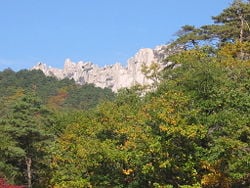
Unlike most older mountains on the mainland, volcanic activity in the Cenozoic orogeny formed many important islands in Korea. Jeju-do, a large volcanic island whose main mountain Mt. Halla (1950 m) stands as the highest in South Korea situates off the southern coast. Ulleung-do, a volcanic island in the Sea of Japan (East Sea), has a greater felsic composition than Jeju-do. The volcanic islands tend to be younger, the more westward.
Because the mountainous region sits mostly on the eastern part of the peninsula, the main rivers tend to flow westwards. The southward-flowing Nakdong River and Seomjin River constitute two exceptions. Important rivers running westward include the Amnok River (Yalu), the Cheongcheon River, the Daedong River, the Han River, the Geum River, and the Yeongsan River. Those rivers have vast flood plains and provide an ideal environment for wet-rice cultivation.
The southern and southwestern coastlines of Korea form a well-developed lias coastline, known as Dadohae-jin in Korean. Its convoluted coastline provides mild seas, and the resulting calm environment allows for safe navigation, fishing, and seaweed farming. In addition to the complex coastline, the western coast of the Korean Peninsula has an extremely high tidal amplitude (at Incheon, around the middle of the western coast, rising as high as 9 m). Vast tidal flats have been developing on the south and west coastlines.
Demographics
Koreans stand number one on the list of homogeneous peoples, all speaking the Korean language. The combined population of the Koreas has been estimated at about 75 million. Small communities of ethnic Chinese and Japanese live in North Korea.[15]
Language
Both North and South Korea declareKorean their official language, and Korean communities abroad widely speak Korean such as neighboring Yanbian, China. Worldwide, approximately eighty million people speak Korean, including large groups in the former Soviet Union, China, Australia, the United States, Canada, Brazil, Japan, and more recently, the Philippines.
The cultural anthropologists and linguists debate Korea's genealogical classification of Korean. Some linguists place Korean in the Altaic language family; others consider the language isolate. In its morphology and SOV in its syntax, Korean has a agglutinative quality. Like Japanese and Vietnamese, Korean has borrowed much vocabulary from the genetically unrelated Chinese or created vocabulary on Chinese models.
Koreans use Hangul script, invented in the fifteenth century, almost exclusively when writing. Modern Korean is written almost exclusively. Hangul, a phonemic alphabet organized into syllabic blocks, appears logographic. Each block consists of at least two of the 24 Hangul letters (jamo): at least one each of the 14 consonants and ten vowels. Historically, the alphabet had several additional letters (see obsolete jamo). For a phonological description of the letters, see Korean phonology. Hangul texts sometimes include Hanja (Chinese characters) and Roman characters, particularly in South Korea.
Culture and Arts
Ancient Chinese texts refer to Korea as "Rivers and Mountains Embroidered in Silk" (錦繡江山) and "Eastern Nation of Decorum." During the seventh and eighth centuries, the Silk Road connected Korea to Arabia. In 845, Arab traders wrote, "Beyond China is a land where gold abounds and which is named Silla. The Muslims who have gone there have been charmed by the country and tend to settle there and abandon all idea of leaving."[16]
Korean festivities often showcase vibrant colors, which have been attributed to Mongolian influences: bright red, yellow, and green often mark traditional Korean motifs. Traditional dress known as hanbok often display those bright colors.
Korean culture's age reckoning system has a unique twist. One year old at birth, individual's age increments on New Year's Day rather than on the anniversary of their birthday. As a result, Koreans add one or two years to their birth age.
Literature
"Classical" or "Traditional" Korean literature refers to writing before the end of the Joseon Dynasty. Traditional literature, written in Chinese characters (hanja), inaugurated when Chinese script arrived on the peninsula, Korean scholars wrote poetry in the classical Chinese style as early as the second century B.C.E., reflecting Korean thoughts and experiences of that time. Classical Korean literature has its roots in traditional folk beliefs and folk tales of the peninsula, strongly influenced by Confucianism, Buddhism and to some extent Daoism.
Modern literature and the development of hangul linked to help spread literacy from the aristocracy to the common people and women. Hangul only reached a dominant position in Korean literature in the second half of the nineteenth century, resulting in a major growth in Korean literature. Sinsoseol, for instance, signify novels written in hangul.
The Korean War led to the development of literature centered around the wounds and chaos of war. Much of the post-war literature in South Korea deals with the daily lives of ordinary people, and their struggles with national pain. The collapse of the traditional Korean value system constitutes another common theme of the time.
Religion and education
Confucian tradition has dominated Korean thought, along with contributions by Buddhism, Daoism, and Korean Shamanism. Since the middle of the twentieth century, Christianity has competed with Buddhism in South Korea, while religious practice has been suppressed in North Korea.
According to 2003 statistics compiled by the South Korean government, about 46 percent of citizens profess to follow no particular religion. Christians account for 27.3 percent of the population and Buddhists 25.3 percent.
Koreans value scholarship, rewarding education and the study of Chinese classic texts; yangban educated boys in Hanja. In Silla, the bone rank system defined a person's social status, and a similar system persisted through the end of the Joseon Dynasty. In addition, the gwageo civil service examination provided paths of upward mobility.
Cuisine
Kimchi, using a distinctive fermentation process of preserving vegetables, may be the best known Korean cuisine. Koreans commonly use Chili peppers, often as chile powder, making the cuisine distinctively spicy.
Bulgogi (roasted marinated beef, chicken, or pork), galbi (ribs), and samgyeopsal (pork fatback) number among the most popular meat entrees. A soup or stew, often made with doenjang (fermented bean paste), usually accompany Korean meals. bibimbap (mixed rice), naengmyeon (cold noodles), galbitang (stewed ribs), and doenjang jjigae (fermentated bean paste stew) number among the most popular dishes.
Science and technology
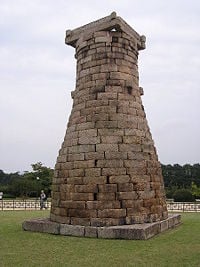
Cheomseongdae, a 9.4-meter high observatory built in 634, stands out as one of the best known artifacts of Korea's history of science and technology, considered one of the world's oldest surviving astronomical observatories.
Chae Yun-ui developed the world's first metal movable type printing press in Korea in 1232 by during the Goryeo Dynasty. Modeled after widespread Chinese clay (Bi Sheng in 1041), Koreans built the printing press before Johann Gutenberg developed his metal letterset type[17] Though Block printing had been used much earlier, metal movable type printing press marked a significant development in printing allowing use of the same tools for more diverse printings. The Jikji stands as the world's earliest remaining movable metal printed book, printed in Korea in 1377.
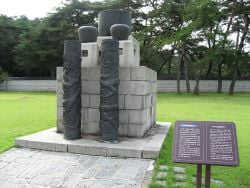
Ch'ilchongsan, developed in 1442 constitutes the apex of astronomical and calendrial advances made under King Sejong. That work enabled scientists to calculate and accurately predict all the major heavenly phenomena, such as solar eclipses and other stellar movements. King Sejong the Great commissioned the creation of Hangul, perhaps the most scientifically designed script in widespread use, in 1443. Jang Yeong-sil invented an automated water clock, the Jagyeokru, which worked by activating motions of wooden figures to indicate time visually, in 1434. Jang later developed a more complicated water-clock with additional astronomical devices, as well as the world's first Iron Printing Press, water gauge, and the rain gauge. Also during the Joseon Dynasty Heo Jun, a court physician wrote a number of medical texts, the most significant Dongeui Bogam, often noted as the defining text of Traditional Korean medicine. The work, still regarded as one of the classics of Oriental medicine, spread to China and Japan.
During the Joseon period, China highly regarded Korean silk and Korean pottery, made with blue-green celadon, considering them the highest quality in the world. Also, during that time, Korean naval architects invented the early ironclad warships, the Geobukseon (Turtle ship),[18] as well as other weapons such as the Bikeokjinchonlae and the hwacha.
See also
Notes
- ↑ Buddhist Art of Korea & Japan, Asia Society Museum. Retrieved July 20, 2020.
- ↑ Delmer M. Brown, (ed.) The Cambridge History of Japan (Cambridge University Press, 1993), 140-149.
- ↑ George Sansom, A History of Japan to 1334 (Stanford University Press, 1958, ISBN 0804705232), 47.
- ↑ Wontack Hong, Ancient Korea - Japan Relations: Paekche and the Origin of the Yamato Dynasty (Seoul: Kudara International, 2010, ISBN 978-8985567060).
- ↑ Sam Kim and Edward Targett, Korea's ancient metallic printing intrigues world Yonhap News, January 18, 2008. Retrieved July 20, 2020.
- ↑ The Ko Choson. asianinfo.org. Retrieved July 20, 2020.
- ↑ The Three Kingdoms. asianinfo.org. Retrieved July 20, 2020.
- ↑ Miura, Goro (1847 - 1926). National Diet Library, Japan. Retrieved July 20, 2020.
- ↑ Yi Tae-jin, "서울대이태진교수의동경대생들에게들려준한국사 : 메이지일본의한국침략사," (Korean History: Korean Edition) (Tae Haksa, 2005, ISBN 8976269993).
- ↑ 山脇 啓造 Keizo Yamawaki, 近代日本と外国人労働者―1890 年代後半と1920年代前半における中国人・朝鮮人労働者問題 Modern Japan and Foreign Laborers: Chinese and Korean Laborers in the late 1890s and early 1920s. 明石書店 Akashi-shorten, 1994, et al. (ISBN 9784750305684)
- ↑ Yoshimi Yoshiaki, Comfort Women. Sexual Slavery in the Japanese Military During World War II, Translated by Suzanne O'Brien. (New York: Columbia University Press, 2001, ISBN 023112032X, originally published by 岩波書店, 1995, ISBN 978-4004303848).
- ↑ 宮田 節子 Setsuko Miyata, "創氏改名" (Creating Surnames and Changing Given Names) 明石書店 (Akashi-shoten, 1992).
- ↑ Gyeongbok Palace. Life in Korea Retrieved July 20, 2020.
- ↑ Bruce Cumings, Korea's place in the sun: a modern history (New York: W.W. Norton, 1997, ISBN 9780393040111), 298.
- ↑ Korea, North. CIA World Factbook.
- ↑ Francois-Bernard Hyghe, The kingdom of Silla and the treasures of Nara. UNESCO Courier, (July 1991). Retrieved July 20, 2020.
- ↑ Cumings, 65.
- ↑ Geobukseon ("Turtle Ship"). Antique Alive. Retrieved July 20, 2020.
ReferencesISBN links support NWE through referral fees
- Brown, Delmer M. (ed.). The Cambridge History of Japan. Cambridge University Press, 1993. ISBN 978-0521223522.
- Byeon, Tae-seop (변태섭) 韓國史通論 (Hanguksa tongnon) (Outline of Korean history), 4th ed., 1999. ISBN 8944591016.
- Cumings, Bruce. Korea's place in the sun: a modern history. New York: W.W. Norton, 1997. ISBN 978-0393040111.
- Cumings, Bruce. The Two Koreas. New York: Foreign Policy Association, 1984. ISBN 978-0871240927.
- Hart, Dennis. From tradition to consumption: construction of a capitalist culture in South Korea. Seoul, Korea: Jimoondang Pub. Co., 2001. ISBN 978-8988095447.
- Hong, Wontack. Ancient Korea - Japan Relations: Paekche and the Origin of the Yamato Dynasty. Seoul: Kudara International, 2010. ISBN 978-8985567060.
- Kim, Yung-Chung. Women of Korea: a history from ancient times to 1945. Seoul, Korea: Ewah Womans University Press, 1976. OCLC 2963936
- Lee, Ki-baik. A New History Of Korea. Cambridge, MA: Harvard University Press, 1984. ISBN 978-0674615755.
- Miyata, Setsuko. Creating Surnames and Changing Given Names. Akashi-shoten, 1992.
- Sansom, George. A History of Japan to 1334. Stanford University Press, 1958. ISBN 0804705232.
- Yang, S.C. The North and South Korean political systems: A comparative analysis, rev. ed. Seoul: Hollym, 1999. ISBN 1565911059.
- Yoshiaki, Yoshimi. Suzanne O'Brien (trans.) Comfort Women. Sexual Slavery in the Japanese Military During World War II. New York: Columbia University Press, 2001. ISBN 023112032X. Originally published by 岩波書店, 1995. ISBN 978-4004303848
External links
All links retrieved March 3, 2025.
- Account of a voyage of discovery to the west coast of Corea, and the great Loo-Choo island, by Captain Basil Hall.
- Corea; or, Cho-sen, by A. Henry Savage-Landor, 1895.
- Korea's History Asian Info.
- Korean Food.
- Korean Language in North and South Korea: The Differences
Credits
New World Encyclopedia writers and editors rewrote and completed the Wikipedia article in accordance with New World Encyclopedia standards. This article abides by terms of the Creative Commons CC-by-sa 3.0 License (CC-by-sa), which may be used and disseminated with proper attribution. Credit is due under the terms of this license that can reference both the New World Encyclopedia contributors and the selfless volunteer contributors of the Wikimedia Foundation. To cite this article click here for a list of acceptable citing formats.The history of earlier contributions by wikipedians is accessible to researchers here:
The history of this article since it was imported to New World Encyclopedia:
Note: Some restrictions may apply to use of individual images which are separately licensed.
